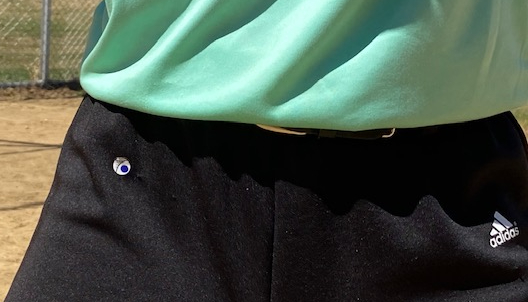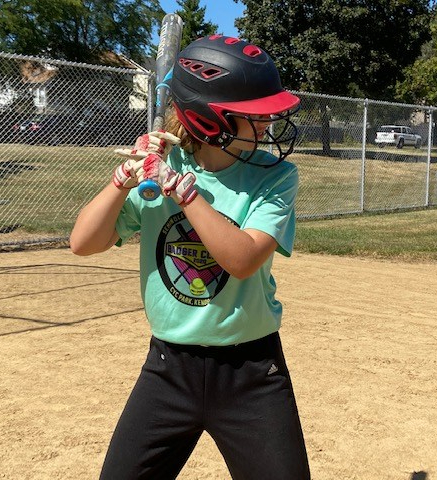Blog Archives
Keep Hitting Toned and Tight Instead of Flabby

A few weeks back I had a hitting student who was having a little trouble getting her bat to the ball most effectively despite her best efforts. She wasn’t hitting badly, but I knew she had more in her.
So, I told her she needed to keep her swing toned and tight instead of letting it go flabby. While that may sound like a rather vague instruction she knew instantly what I meant, made the adjustment, and started hitting bombs.
I have since used it with several other students and it always produces the desired results. It’s a language the kids can understand. But what does it really mean?
Basically, it refers to being efficient. A flabby swing is one where there is a lot of extraneous movement either at certain points or throughout the swing.
One example of flabbiness in a swing is over-loading the body overall or even just the hands. Pushing back over the back leg, or lifting the hands way up and/or back before bringing them forward is inefficient.
Casting the hands out away from the body as you start to turn is another example. That movement will make the swing take too long to execute, and disconnecting the hands from the shoulders prematurely will cause a lot of the potential energy to leak out before it can be turned into kinetic energy at impact.
In a toned and tight swing, the body load will go into the back leg instead of over it. I refer to that as “bouncing off” the back leg.
That will be a quick, easy movement designed to break inertia instead of trying to make it a power generator. The power generation comes with the turn.
If the hands pull too far back up and/or back, you’ve created a longer path to the ball that will make it harder to be on-time. You’ve also made it more likely that you will try to generate too much of the power from the shoulders instead of letting the lower body drive the swing.
In a toned and tight swing, the hands will stay close to the back shoulder (I call it “in the bubble”) until the lower body has turned about 45 degrees. By that point you will have a better idea of where the ball will be when it enters the hitting zone AND you will have a shorter path to get there.
A toned and tight swing will also let the lower body/core provide the bulk of the power while the upper body rides that wave for most of the swing. That’s important, because when you try to generate too much power from the upper body you end up giving up control of the bat.
A lower body/core-driven swing makes it far easier to direct the bat where you want it to go. Why? Because you haven’t generated early momentum with the bat that is going to carry it to a particular area before you’re sure of what area you need to take the bat to.
Instead, you can use the largest muscles in the body, which incidentally can do little to nothing to influence where the bat goes, to create power, while letting the parts that are closest to the bat guide its path more fluidly – and directly.
The result is a more effortless swing that efficiently delivers power more precisely to where it needs to go, creating more and better hits that will help the hitter raise her batting average (BA), on-base percentage (OBP), slugging percentage (SLG), and on base plus slugging percentage(OPS).
Can you say all that without the toned and tight v flabby descriptor? Sure. I certainly have.
But all the technical talk may not resonate as well. If, however, you tell her what you want and then add the idea of making the swing toned and tight it seems to get through better. At least in my experience.
So if you have a hitter who is struggling a little to get her swing more efficient, give this one a try. It just might work for you too.
Photo by Scott Webb on Pexels.com
“Hip Eye” Helps Encourage Driving the Back Side When Hitting

A few weeks ago I wrote about a cue I’d developed called “shoulder eye.” It’s worth reading the full post, but if you’re pressed for time the core concept is placing an eye sticker on the shoulder, then making sure the shoulder comes forward to see the ball before it tilts in.
Then last week I ran into another issue where the eye stickers came in handy.
In this case it was a fairly new student who was having some challenges getting the hang of driving her back hip around the front side to initiate her swing. She’d done fine off the tee, but when we moved to front toss she just couldn’t help but lead with her hands as she has since she started playing.

So… off to my bag of tricks I went, and I came back with an eye sticker. I told her to place it on her back (in this case right) hip. (If you look closely at the top or the full-length photo you can see it.)
I then told her that in order to hit the ball, she had to make sure her “hip eye” came around to get a good look at the ball before starting her hands.
As with shoulder eye I’m not 100% of why this works. But I’m happy to report that it does.
My guess is that placing the eye on the hip (or shoulder) creates more of a, pardon the pun, visual for the hitter. Perhaps “bring your hip around” is too vague, whereas point this eye toward the ball first is more specific.
Or it could just be goofy enough to break well-established, unconscious thought patterns to enable new information to take over.
In any case, it seems to work. I’ve used it a couple of times since that first one and the difference was immediate.
The hitter wasn’t necessarily perfect – I like a lot of drive out of the back side. But it definitely set her down the right path.
So if you have a hitter who is having trouble latching onto the proper sequences of hips-shoulders-bat, or who isn’t using her hips at all, get some eyeball stickers and have her place it on her back hip. It might be just what she needs to start hitting with authority.
For Better Hitting, Use Your Shoulder Eye
While it might sound like this is a post specifically for mutants, “shoulder eye” is a concept I came up with to help hitters stop dropping their back shoulders toward the catcher before they begin to rotate their hips to fire the swing. The premise is you want the imaginary eye on your shoulder to turn and get a look at the ball before you start to tilt into the swing.
This is an issue I see all the time, especially on low pitches. As soon as a hitter spots that the pitch is low, he/she will start dropping the shoulder to get down to the ball. That’s just wrong on so many levels.
For example, if you drop the shoulder back and down instead of bringing it forward first you lose the ability to fully adjust to pitch locations. You’re kind of locked into a zone, and if you guessed wrong there isn’t much you can do about it except swing and miss or hit a weak ground ball or popup.
If you turn first, keeping the shoulder up, you can then take a little more time (even if it’s just a couple hundredths of a second, everything helps) to see where the ball is, then tilt only as much as is needed. You can work from high to low, enabling you to cover more of the strike zone AND get a better bat angle.
Another issue with dropping back is that it tends to restrict your ability to move the hips forward effectively. All your weight is pressing down on your back side making it difficult rotate quickly and efficiently. Even if you get your hips to turn you won’t be generating much power out of them.
If you turn your shoulder eye forward first, you can unweight your back side so it can drive quickly around your front side and generate power. You can then get a proper hips-shoulders-bat swing that will help you drive balls into the gap or over the fence rather than seeing most of your contacts end up staying in the infield.
The idea of not dropping the back shoulder toward the catcher before rotation isn’t new, by the way. It’s a fairly standard instruction.
Hitters are told to land with their front shoulder lower than the back, turn a certain way, and do all sorts of other things. But they don’t always understand the instruction in a way that makes it easy to execute.
The shoulder eye concept does. Telling a hitter he/she has an eye on the shoulder, and it has to look forward before the shoulder drops, is visual (no pun intended) and easy to understand.
Originally I would tell hitters just to visualize the shoulder eye. But then one day it occurred to me – why not give them an actual shoulder eye?
A few bucks on Amazon later I had enough stickers to teach a small army of hitters. With 4,000 of them I’m guessing it’s a lifetime supply, even with my habit of giving a few to hitters who want to use them at home or at practice as well.
And why not? It’s fun and effective. Even my students who are college players like the stickers and find the concept valuable in helping them hit bombs.
So if you have a hitter who just loves to drop that back shoulder and sit on the back side, open his/her eyes to the shoulder eye. In my experience it’s a real difference-maker.







